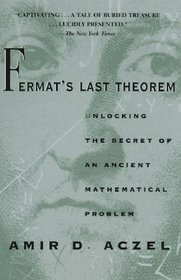James M. reviewed Fermat's Last Theorem : Unlocking the Secret of an Ancient Mathematical Problem on + 9 more book reviews
This was an interesting discussion of all the efforts by many individuals to solve this problem. The problem is so simple that a high school student might think they could solve it by finding an exception to the rule but clearly it is not. A^2 + B^2 = C^2 or 3^2 + 4^2 = 5^2. Fermat says he can prove there are no solutions for cubes or higher that result in all integers. The final solution that is presented is very complicated and totally lacks mathematical elegance. Certainly not something Fermat would have come up with. Maybe there is more to come on the subject
Angela B. reviewed Fermat's Last Theorem : Unlocking the Secret of an Ancient Mathematical Problem on + 82 more book reviews
Interesting story but a little over my head with some of the math!
Edgar E. reviewed Fermat's Last Theorem : Unlocking the Secret of an Ancient Mathematical Problem on
I just want to point out that Wiles' proof of Fermant's last theorem has two fatal defects:
1) The field axioms of the real number system are inconsistent; Felix Brouwer and this blogger provided counterexamples to the trichotomy axiom and Banach-Tarski to the completeness axiom, a variant of the axiom of choice. Therefore, the real number system is ill-defined and FLT being formulated in it is also ill-defined. What it took to resolve this conjecture was to first free the real number system from contradiction by reconstructing it as the new real number system on three simple consistent axioms and reformulating FLT in it. With this rectification of the real number system, FLT is well-defined and resolved by counterexamples proving that it is false.
2) The other fatal defect is that the complex number system that Wiles used in the proof being based on the vacuous concept i is also inconsistent. The element i is the vacuous concept: the root of the equation x^2 + 1 = 0 which does not exist and is denoted by the symbol i = sqrt(-1) from which follows that,
i = sqrt(1/-1) = sqrt 1/sqrt(-1) = 1/i = i/i^2 = -i or
1 = -1 (division of both sides by i),
2 = 0, 1 = 0, I = 0, and, for any real number x, x = 0,
and the entire real and complex number systems collapse. The remedy is in the appendix to the paper, The generalized integral as dual to Schwarz distribution.. In general, any vacuous concept yields a contradiction.
E. E. Escultura
Research Professor
V. Lakshmikantham Institute for Advanced Studies
GVP College of Engineering, JNT University
1) The field axioms of the real number system are inconsistent; Felix Brouwer and this blogger provided counterexamples to the trichotomy axiom and Banach-Tarski to the completeness axiom, a variant of the axiom of choice. Therefore, the real number system is ill-defined and FLT being formulated in it is also ill-defined. What it took to resolve this conjecture was to first free the real number system from contradiction by reconstructing it as the new real number system on three simple consistent axioms and reformulating FLT in it. With this rectification of the real number system, FLT is well-defined and resolved by counterexamples proving that it is false.
2) The other fatal defect is that the complex number system that Wiles used in the proof being based on the vacuous concept i is also inconsistent. The element i is the vacuous concept: the root of the equation x^2 + 1 = 0 which does not exist and is denoted by the symbol i = sqrt(-1) from which follows that,
i = sqrt(1/-1) = sqrt 1/sqrt(-1) = 1/i = i/i^2 = -i or
1 = -1 (division of both sides by i),
2 = 0, 1 = 0, I = 0, and, for any real number x, x = 0,
and the entire real and complex number systems collapse. The remedy is in the appendix to the paper, The generalized integral as dual to Schwarz distribution.. In general, any vacuous concept yields a contradiction.
E. E. Escultura
Research Professor
V. Lakshmikantham Institute for Advanced Studies
GVP College of Engineering, JNT University




